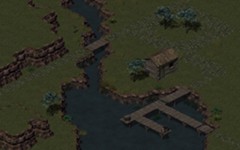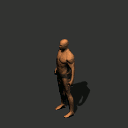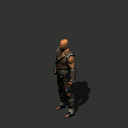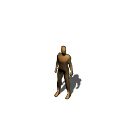Translations
First, I want to thank everyone sending in translations. You guys are awesome, and it makes testing our newest code that much easier.
However, fair warning: all of this data is subject to change. The current game data amounts to a short tech demo, and it’s very possible that all of it will be discarded before the first game is complete.
It’s certainly nice if people in many countries can experience the tech demo in their native language. But don’t worry about a huge concentrated effort to translate the current data into everything. We can have a strong localization effort further down the road.
It might look to the layman that the game is near feature-complete, but that still means the game itself is just starting. We’re far enough into the game design process to see which parts of the gameplay don’t work. There will be some redesigning, and thus translations will become obsolete. So let’s talk about that.
Gameplay Thoughts
A couple weeks ago I picked up Dark Souls. It’s the first console game I’ve played since… hm, since Ocarina of Time or Symphony of the Night. I’m absolutely loving it, especially as a great example of hard melee combat.
It’s making me rethink some game design choices. Although the engine itself should support several options, a great game could use some tweaks. Here are some ideas I’m tossing around.
Defense
I like the low number scale in the game currently — it’s a bit easier to visualize. But there’s hardly room for varied armor when light armor is 1 absorb and heavy armor is 2 absorb. This is more affected by shields which have passive absorb. So I’m toying with changing the armor and shield system.
What if shields didn’t have passive absorb, but instead required using active Block to have an effect? E.g. a Wood Buckler could have “Absorb 5 while blocking”. Heavy enemy attacks could still power through such a shield, but weaker attacks would be fully absorbed.
By moving shield absorption to active Blocking, it’s okay to allow higher passive armor ratings. And allow more armor. I’d want more armor styles that span the Defense rating from 1-5. I don’t like how the Defense skill currently alternates between unlocking armor and shields. Each level should give both. The baseline armors/shields could look like this:
- Leather (Absorb 1, requires Def 2)
- Maille (Absorb 2, requires Def 3)
- Plate (Absorb 3, requires Def 4)
- Dragonscale (Absorb 4, requires Def 5)
- Buckler (Block 3, requires Def 2)
- Small Shield (Block 6, requires Def 3)
- Large Shield (Block 9, requires Def 4)
- Tower Shield (block 12, requires Def 5)
Enchanted or special gear could have higher bonuses.
Character Menu
Because of the above, and similar changes I have in mind, I want to remove the item proficiency visuals from the Character menu. This will add more flexibility in gear design. Example: we can have a Warhammer that requires Physical 3, and we don’t have to think of a name for the class of weapons that requires Physical 3.
Resistance
Right now in the engine, elemental resistance (damage reduced by a percentage) is treated differently than physical resistance (damage reduced by a fixed number). One could argue to combine these systems to all be like physical damage is currently. Then, each attack could have a damage type (physical, or a specific element) and an entity could have damage reduction per type. This could somewhat simplify the code, as all damage is handled the same way.
What are the pros/cons for the player? I’m not sure. One thing is, percent-based gear scales with enemy damage, so one particular piece of gear is useful for longer. This means less inventory management and gear feeling more special, but it could also mean few pieces of gear trivializing large parts of a game.
It’s possible for every armor/shield to list damage absorption for each type. It leads to having a ton of numbers on each piece of loot, and that’s just a bit overwhelming.
Equipment Slots
So, it’s relatively easy to support these visual equipment slots: chest, legs, arms, head, both hands. Anything more complex would be hard to do with layered sprites.
But, are gloves and boots actually exciting? I suppose it is neat to mix and match equipment for visual looks (how much does this matter in an isometric sprite-based game?). Min/maxing gloves or boots stats seems a bit tedious to me. If gloves/boots always have unique effects and no armor value, I’m more excited. (e.g. acidwalk boots)
There is satisfaction with getting a whole matching set of armor, but some players end up sacrificing style to mix up optimal stats. Maybe it’s okay for armor to all come in one piece, so that the player is stylish and only has to make one stat choice. Maybe having single-slot armor is less “hardcore”, I don’t know.
Stats
I’m considering removing health and mana regen as regular stats in the game (I’d leave code support for them though). Health regen makes some games cheap (I’m not intimidated by the next fight if I can always rest up to full) and tedious (I’m spending more time waiting for health to come back than actually fighting). When a game doesn’t have regenerating health it encourages players to get better at combat to clear new areas.
One problem I have with health and health regen being separate stats: it’s not obvious the best way to improve your character. Why have two stats that essentially do the same thing?
If there’s no health regen, then healing spells and potions become way more important. But if there’s no practical limit on those healing items/spells, someone without them (e.g. melee builds?) have a large disadvantage.
What about mana regen? It would hurt to be a caster with limited mana. Instead of a “mana regen” stat, maybe mana should have a standard regen rate that scales with max mana (e.g. 10 seconds to regen 100% mana). Weapons with mana drain could be very helpful.
Mundane vs. Magical
This is a personal preference: a game world where magic is too prevalent is boring. I’d rather have more interesting mundane items, and any magical item to be rare and wondrous.
I really like the weapon/armor upgrade system in Dark Souls. I had a similar, less refined idea going when I originally created those gemstone icons. Maybe I’ll look into an Enchanting system for Flare, where you combine one equipment and one rare consumable to make upgraded equipment.
Selling to Vendors vs. Crafting
I don’t know if this is necessary. It doesn’t make sense in most game worlds, and is just there because of tradition at this point.
If I had a crafting system, I’d rather have items useful for their base components rather than being vendor trash. Longswords and bows could be scrapped into steel ingots and wood rods, which could then be used to build other base items.
Melee Attack Animations
When I create the planned upgraded art for Flare, I want to put in different melee attack animations. I haven’t decided on the set I need, but imagine if there was an overhead smash, an uppercut swing, left and right hooks, and lunge/jab. I could make it so that these animations are used randomly so that combat simply looks interesting. I could make it so that each weapon uses one animation when standing still and a different animation if you attacked while moving (perhaps with different damage for each). I could have each weapon type affect the speed of each animation. I could have certain powers use specific animations.
Making Melee Fun
Combat can be more interactive if creatures have “tells” before they use an attack; e.g. a big wind-up before a huge swing. That would give time for the player to dodge or block. It would require more thought put into each creature but it could be well worth it. Right now there’s really no time to react to what a creature does if you’re in melee range; at best you can hold block while waiting for an attack, then counter-attack (which isn’t too bad, really).
I’ve read interesting articles on how to make melee combat feel “crunchy”. Instead of having a melee swing always follow through at the same speed, it feels better when the animation pauses slightly on the frame where the hit lands. It gives the attacks weight, rather than just feeling like all combat is simply swinging at ghosts.
Blocking should have some small effect on the attacker, maybe a higher-than-usual cooldown time before they may attack again. This could mimic “staggering” an enemy with a successful block and give time for the player to land a counter swing.






